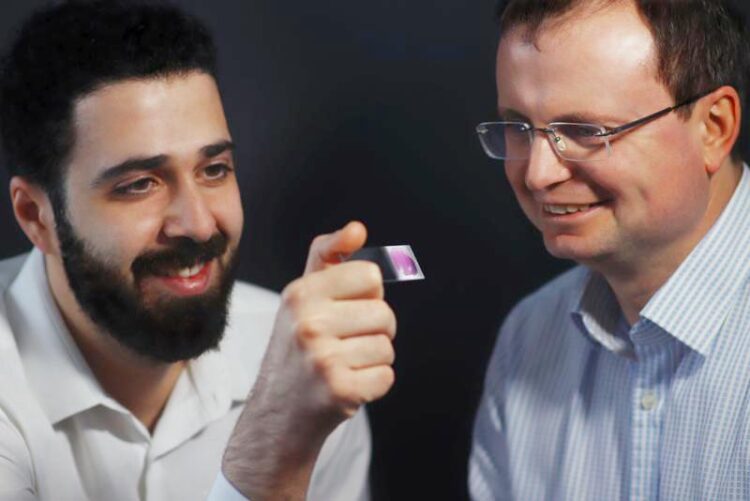3D printing technology for tissue

Waseem Kitana and Leonid Ionov
(c) UBT
Bayreuth researchers combine hydrogels and fibres in a new technology.
Prof. Dr Leonid Ionov and his team at the University of Bayreuth have developed a new type of 3D printing technology that combines hydrogels and fibres. The innovative process, combined in one device for the first time, enables the production of constructs with fibrous structures and uniaxial cell alignment. The research results, published in the journal “Advanced Healthcare Materials”, harbour potential for the artificial production of biological tissue.
In the latest study by Prof Dr Leonid Ionov, Professor of Biofabrication, and his team at the University of Bayreuth, various types of hydrogels were extensively tested for the 3D printing of tissues. A hydrogel is a water-retaining and at the same time water-insoluble polymer. In addition, the cell containing-hydrogels, also known as bioink, are combined with fibres to create a composite material. This is achieved by using 3D (bio) printing with an integrated touch-spinning process. Touch spinning is a scalable process for producing of fibres from a polymer solution or melt. The Bayreuth scientists have now combined 3D (bio) printing technology with touch-spinning technology in a single device for the first time.

Graphic of the 3D bio-printing method. (c) Universität Bayreuth
“The insights gained in this study are of great importance for the production of tissues and in particular tissues with fibrous structures and uniaxial alignment of cells such as connective and muscle tissue,” explains Prof. Dr Leonid Ionov. In an article recently published in the journal “Advanced Healthcare Materials”, the Bayreuth researchers Prof. Dr. Dr. Elisabetta Ada Cavalcanti-Adam, Chair of Cellular Biomechanics, Prof. Dr. Leonid Ionov, Professor of Biofabrication, Waseem Kitana, PhD student at the Chair of Biofabrication, and their colleague Dr. Victoria Levario-Diaz from the Max Planck Institute for Medical Research, report on a novel approach for the production of multilayer bioink fibre composites.
The Bayreuth scientists used various hydrogels in the experiments and compared their properties. Hydrogels have been widely used as scaffold materials in the fields of tissue engineering and biofabrication for decades. Tissue engineering is the umbrella term for the artificial production of biological tissues.
The combination of a hydrogel system with a fibre system reduces the processing requirements for hydrogels, such as cross-linking to improve their mechanical properties, as the mechanical properties of these composite materials are covered by the fibre system. In addition, the requirement for a low degree of cross-linking is advantageous for subsequent tissue formation. “The hydrogel provides the cells with an aqueous environment that promotes the good functioning of the cells, while the fibres should control the orientation of the cells along the main direction of the fibre,” says Prof. Ionov.
Building on the invention of the new and already patented device that combines these two techniques, the Bayreuth scientists have founded the start-up company “biovature GmbH” under the leadership of PD Dr habil. Alla Synytska (co-founder and CEO).
The German Research Foundation (DFG) research cluster SFB/TRR 225 provided financial support for the research.
Wissenschaftliche Ansprechpartner:
Prof. Dr. Leonid Ionov
Professor für Biofabrikation
E-Mail: Leonid.Ionov@uni-bayreuth.de
Tel.: +49 (0) 921 / 55-5543
Originalpublikation:
W. Kitana, V. Levario-Diaz, E. A. Cavalcanti-Adam, L. Ionov, Biofabrication of Composite Bioink-Nanofiber Constructs: Effect of Rheological Properties of Bioinks on 3D (Bio)Printing and Cells Interaction with Aligned Touch Spun Nanofibers. Adv. Healthcare Mater. 2023, 2303343. https://doi.org/10.1002/adhm.202303343
Media Contact
All latest news from the category: Process Engineering
This special field revolves around processes for modifying material properties (milling, cooling), composition (filtration, distillation) and type (oxidation, hydration).
Valuable information is available on a broad range of technologies including material separation, laser processes, measuring techniques and robot engineering in addition to testing methods and coating and materials analysis processes.
Newest articles

NASA: Mystery of life’s handedness deepens
The mystery of why life uses molecules with specific orientations has deepened with a NASA-funded discovery that RNA — a key molecule thought to have potentially held the instructions for…

What are the effects of historic lithium mining on water quality?
Study reveals low levels of common contaminants but high levels of other elements in waters associated with an abandoned lithium mine. Lithium ore and mining waste from a historic lithium…

Quantum-inspired design boosts efficiency of heat-to-electricity conversion
Rice engineers take unconventional route to improving thermophotovoltaic systems. Researchers at Rice University have found a new way to improve a key element of thermophotovoltaic (TPV) systems, which convert heat…



